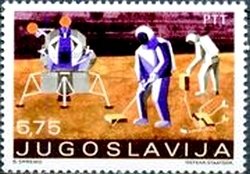Stamp: "Apollo 11" landing on the moon (Yugoslavia 1971)
"Apollo 11" landing on the moon (Yugoslavia 1971)
01 January (Yugoslavia ) within release Space Research goes into circulation Stamp "Apollo 11" landing on the moon face value 5.75 Yugoslav dinar
| Stamp "Apollo 11" landing on the moon in catalogues | |
|---|---|
| Michel: | Mi:YU 1415 |
Stamp is horizontal format.
Also in the issue Space Research:
- Stamp - Satelites of France, Britain, Italy and Canada face value 0.50;
- Stamp - Artificial satelite face value 0.75;
- Stamp - Unmanned rockets destined for the moon face value 1.25;
- Stamp - Various space probes face value 2.50;
- Stamp - First space station "Sojus" face value 3.25;
- Stamp - "Apollo 11" landing on the moon face value 5.75;
Stamp "Apollo 11" landing on the moon it reflects the thematic directions:
The Moon is Earth's only natural satellite. It orbits at an average distance of 384,400 km (238,900 mi), about 30 times the diameter of Earth. Tidal forces between Earth and the Moon have over time synchronized the Moon's orbital period (lunar month) with its rotation period (lunar day) at 29.5 Earth days, causing the same side of the Moon to always face Earth. The Moon's gravitational pull – and to a lesser extent, the Sun's – are the main drivers of Earth's tides.
A spacecraft is a vehicle that is designed to fly and operate in outer space. Spacecraft are used for a variety of purposes, including communications, Earth observation, meteorology, navigation, space colonization, planetary exploration, and transportation of humans and cargo. All spacecraft except single-stage-to-orbit vehicles cannot get into space on their own, and require a launch vehicle (carrier rocket).
An astronaut (from the Ancient Greek ἄστρον (astron), meaning 'star', and ναύτης (nautes), meaning 'sailor') is a person trained, equipped, and deployed by a human spaceflight program to serve as a commander or crew member aboard a spacecraft. Although generally reserved for professional space travelers, the term is sometimes applied to anyone who travels into space, including scientists, politicians, journalists, and tourists




